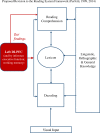Brain basis of cognitive resilience: Prefrontal cortex predicts better reading comprehension in relation to decoding
- PMID: 29902208
- PMCID: PMC6002103
- DOI: 10.1371/journal.pone.0198791
Brain basis of cognitive resilience: Prefrontal cortex predicts better reading comprehension in relation to decoding
Abstract
Objective: The ultimate goal of reading is to understand written text. To accomplish this, children must first master decoding, the ability to translate printed words into sounds. Although decoding and reading comprehension are highly interdependent, some children struggle to decode but comprehend well, whereas others with good decoding skills fail to comprehend. The neural basis underlying individual differences in this discrepancy between decoding and comprehension abilities is virtually unknown.
Methods: We investigated the neural basis underlying reading discrepancy, defined as the difference between reading comprehension and decoding skills, in a three-part study: 1) The neuroanatomical basis of reading discrepancy in a cross-sectional sample of school-age children with a wide range of reading abilities (Experiment-1; n = 55); 2) Whether a discrepancy-related neural signature is present in beginning readers and predictive of future discrepancy (Experiment-2; n = 43); and 3) Whether discrepancy-related regions are part of a domain-general or a language specialized network, utilizing the 1000 Functional Connectome data and large-scale reverse inference from Neurosynth.org (Experiment-3).
Results: Results converged onto the left dorsolateral prefrontal cortex (DLPFC), as related to having discrepantly higher reading comprehension relative to decoding ability. Increased gray matter volume (GMV) was associated with greater discrepancy (Experiment-1). Region-of-interest (ROI) analyses based on the left DLPFC cluster identified in Experiment-1 revealed that regional GMV within this ROI in beginning readers predicted discrepancy three years later (Experiment-2). This region was associated with the fronto-parietal network that is considered fundamental for working memory and cognitive control (Experiment-3).
Interpretation: Processes related to the prefrontal cortex might be linked to reading discrepancy. The findings may be important for understanding cognitive resilience, which we operationalize as those individuals with greater higher-order reading skills such as reading comprehension compared to lower-order reading skills such as decoding skills. Our study provides insights into reading development, existing theories of reading, and cognitive processes that are potentially significant to a wide range of reading disorders.
Conflict of interest statement
The authors have declared that no competing interests exist.
Figures




Similar articles
-
Distinct neural substrates of individual differences in components of reading comprehension in adults with or without dyslexia.Neuroimage. 2021 Feb 1;226:117570. doi: 10.1016/j.neuroimage.2020.117570. Epub 2020 Nov 19. Neuroimage. 2021. PMID: 33221445 Free PMC article.
-
Anomalous gray matter patterns in specific reading comprehension deficit are independent of dyslexia.Ann Dyslexia. 2016 Oct;66(3):256-274. doi: 10.1007/s11881-015-0114-y. Epub 2016 Jun 20. Ann Dyslexia. 2016. PMID: 27324343 Free PMC article.
-
Individualized Prediction of Reading Comprehension Ability Using Gray Matter Volume.Cereb Cortex. 2018 May 1;28(5):1656-1672. doi: 10.1093/cercor/bhx061. Cereb Cortex. 2018. PMID: 28334252 Free PMC article.
-
Reading disorders and dyslexia.Curr Opin Pediatr. 2016 Dec;28(6):731-735. doi: 10.1097/MOP.0000000000000411. Curr Opin Pediatr. 2016. PMID: 27496059 Free PMC article. Review.
-
Developmental dyslexia: an update on genes, brains, and environments.J Child Psychol Psychiatry. 2001 Jan;42(1):91-125. J Child Psychol Psychiatry. 2001. PMID: 11205626 Review.
Cited by
-
Decoding the role of the cerebellum in the early stages of reading acquisition.Cortex. 2021 Aug;141:262-279. doi: 10.1016/j.cortex.2021.02.033. Epub 2021 May 8. Cortex. 2021. PMID: 34102410 Free PMC article.
-
The Role of Neural and Genetic Processes in Learning to Read and Specific Reading Disabilities: Implications for Instruction.Read Res Q. 2023 Apr-Jun;58(2):203-219. doi: 10.1002/rrq.439. Epub 2021 Aug 4. Read Res Q. 2023. PMID: 37456924 Free PMC article.
-
Children Use Regions in the Visual Processing and Executive Function Networks during a Subsequent Memory Reading Task.Cereb Cortex. 2019 Dec 17;29(12):5180-5189. doi: 10.1093/cercor/bhz057. Cereb Cortex. 2019. PMID: 30927366 Free PMC article.
-
Distinct neural substrates of individual differences in components of reading comprehension in adults with or without dyslexia.Neuroimage. 2021 Feb 1;226:117570. doi: 10.1016/j.neuroimage.2020.117570. Epub 2020 Nov 19. Neuroimage. 2021. PMID: 33221445 Free PMC article.
-
Structural white matter characteristics for working memory and switching/inhibition in children with reading difficulties: The role of the left superior longitudinal fasciculus.Netw Neurosci. 2022 Jul 1;6(3):897-915. doi: 10.1162/netn_a_00257. eCollection 2022 Jul. Netw Neurosci. 2022. PMID: 36605413 Free PMC article.
References
-
- García JR, Cain K. Decoding and reading comprehension: a meta-analysis to identify which reader and assessment characteristics influence the strength of the relationship in english. Rev Educ Res. 2014;84(1):74–111.
-
- LaBerge D, Samuels SJ. Toward a theory of automatic information processing in reading. Cogn Psychol. 1974;6(2):293–323.
-
- Landi N, Frost SJ, Mencl WE, Sandak R, Pugh KR. Neurobiological bases of reading comprehension: Insights from neuroimaging studies of word-level and text-level processing in skilled and impaired readers. Read Writ Q. 2013;29(2):145–67. doi: 10.1080/10573569.2013.758566 - DOI - PMC - PubMed
-
- Hudson N, Scheff J, Tarsha M, Cutting LE. Reading comprehension and executive function neurobiological findings. Perspect Lang Lit. 2016;42(2):23–9.
-
- Stuebing KK, Fletcher JM, LeDoux JM, Lyon GR, Shaywitz SE, Shaywitz BA. Validity of IQ-Discrepancy Classifications of Reading Disabilities: A Meta-Analysis. American Educational Research Journal. 2002;39(2):469–518.
Publication types
MeSH terms
Grants and funding
- K23 HD054720/HD/NICHD NIH HHS/United States
- R01 HD065794/HD/NICHD NIH HHS/United States
- R37 HD095519/HD/NICHD NIH HHS/United States
- R01 HD067254/HD/NICHD NIH HHS/United States
- R21 HD087088/HD/NICHD NIH HHS/United States
- U54 HD083211/HD/NICHD NIH HHS/United States
- P01 HD001994/HD/NICHD NIH HHS/United States
- R01 HD078351/HD/NICHD NIH HHS/United States
- R01 HD044073/HD/NICHD NIH HHS/United States
- P50 HD052120/HD/NICHD NIH HHS/United States
- R01 HD089474/HD/NICHD NIH HHS/United States
- R01 HD086168/HD/NICHD NIH HHS/United States
LinkOut - more resources
Full Text Sources
Other Literature Sources

